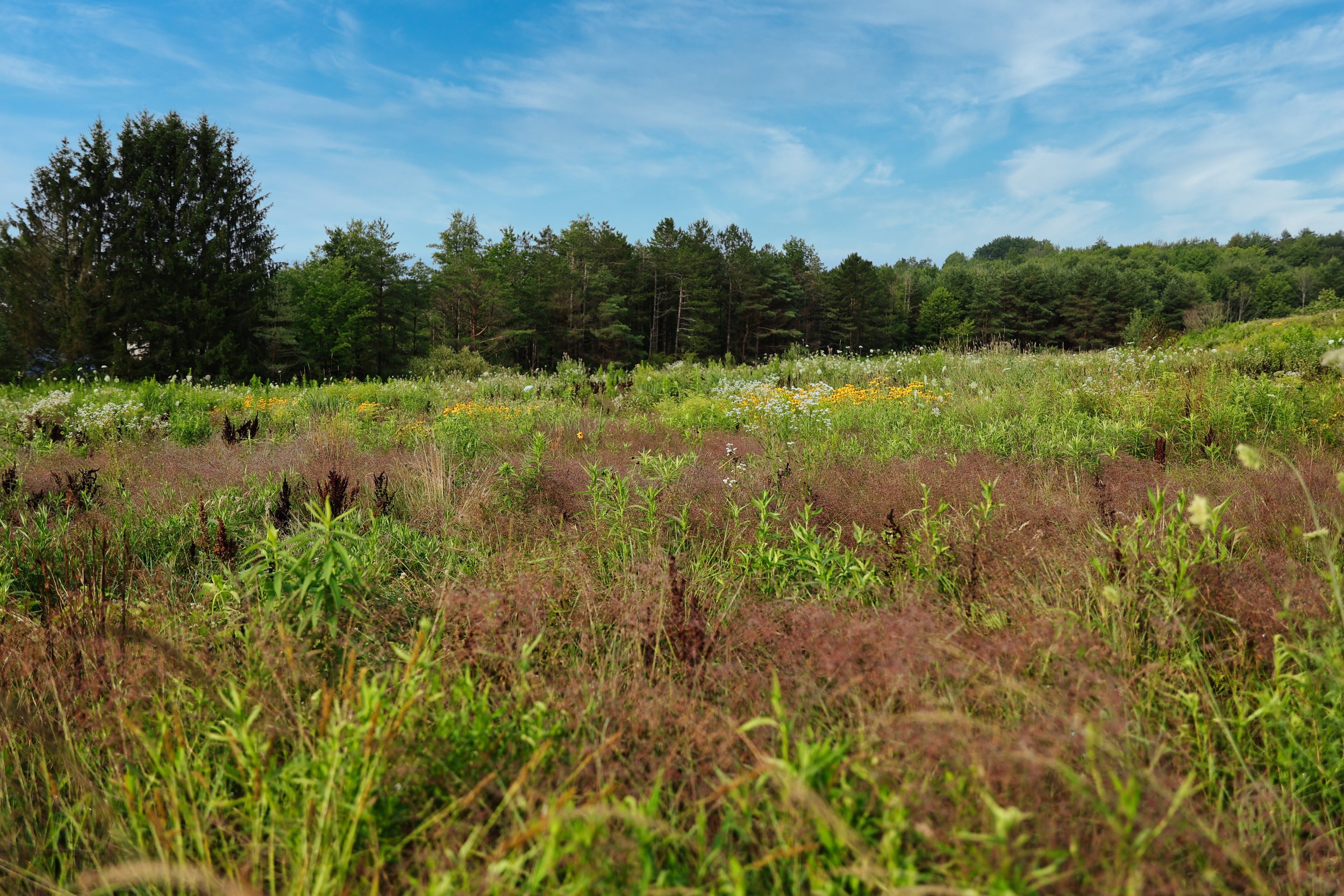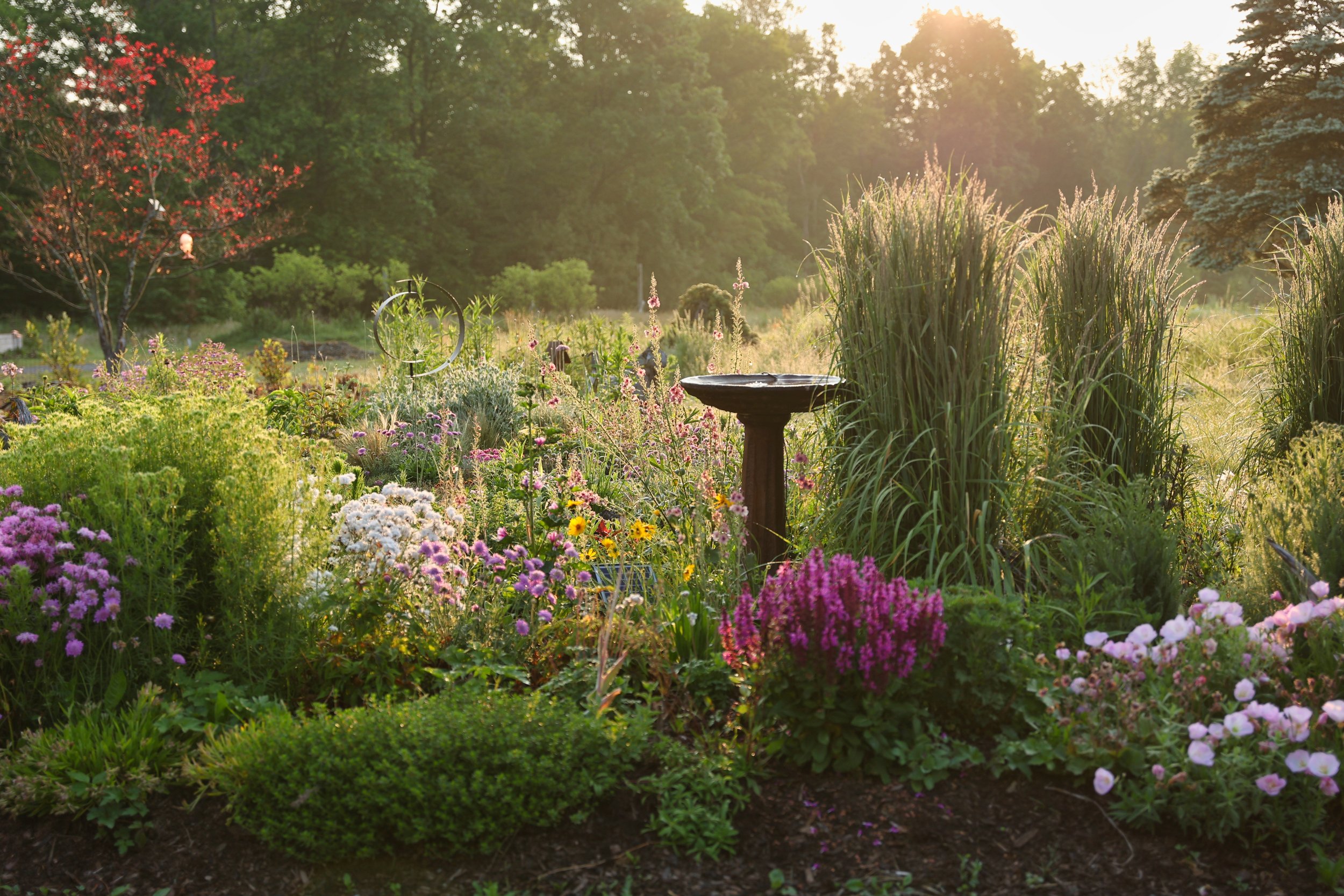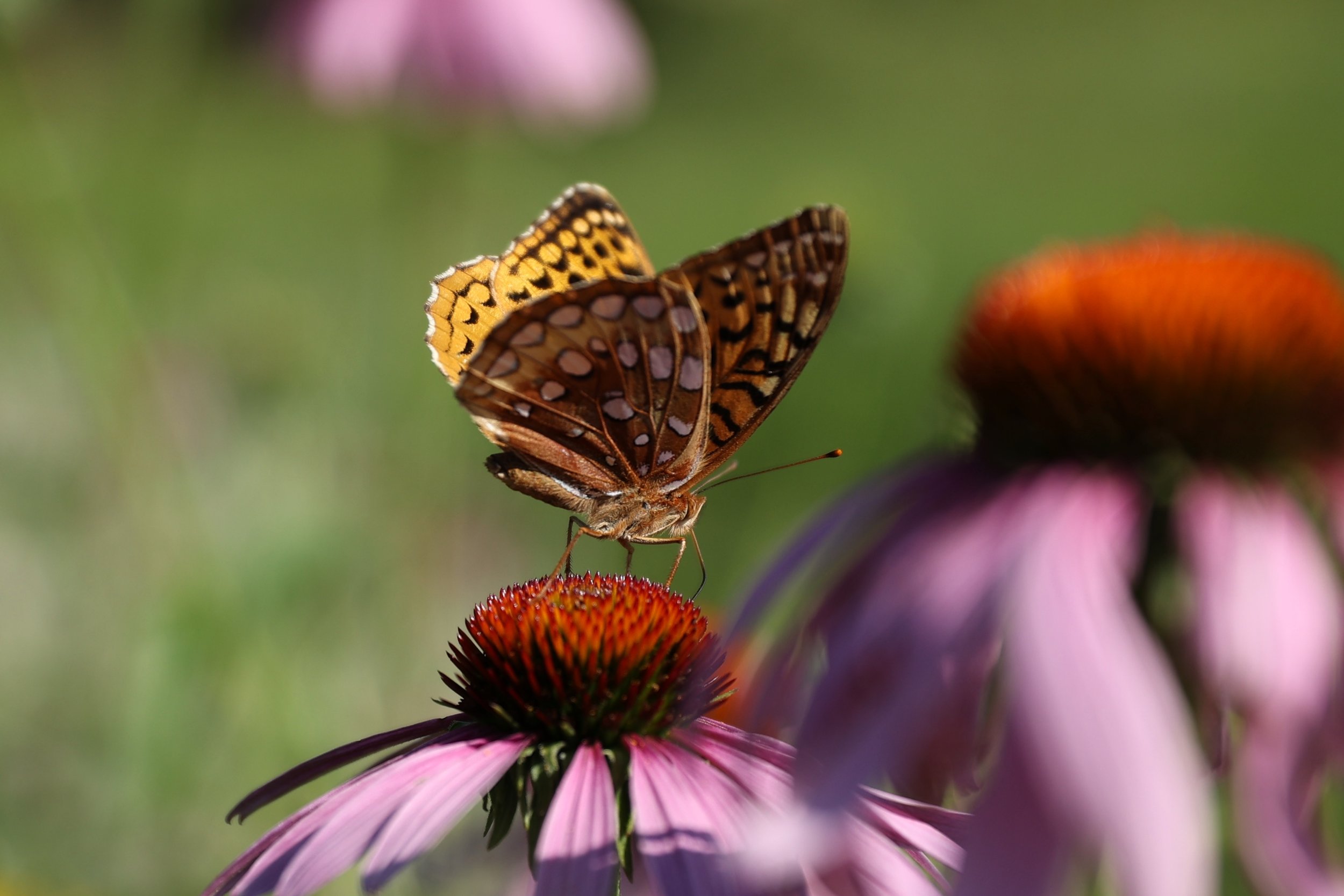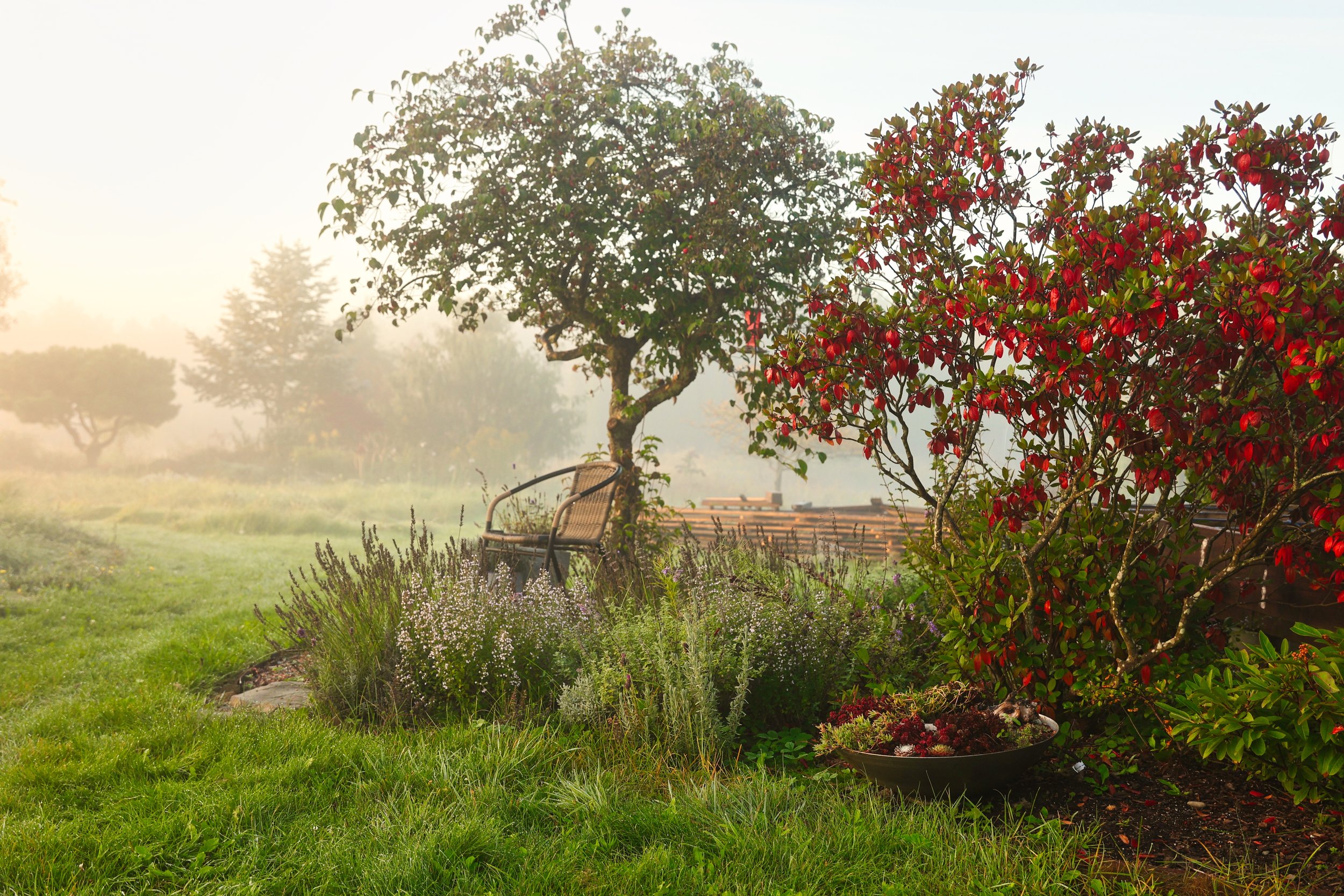Landscapes & Gardens
In 2021, we began the long but rewarding process of revitalizing and beautifying the land with a series of landscape and garden projects designed to serve wildlife, restore ecosystem function and services, and knit the entire landscape together.
Since that time, we have embarked on over a dozen garden and landscaping projects—some of them experimental and for which we share our results on our YouTube channel. Over 2100 different types of plants have been incorporated into the landscape plantings with an emphasis on native plants. Nearly 40 percent are native to the High Allegheny Plateau Ecoregion and New York state. We’re committed to working with the land and co-creating more pleasing spaces that can be fully enjoyed and utilized by all who live here and visit.
The Native Insect
Meadow
Nearly 96 tons of trash—from geotextile material to tile drainage—and thousands of invasive honeysuckle and multiflora rose—were removed from this 9-acre former container nursery site in June of 2021. After that, the area was graded and prepped for planting a native insect meadow. Before that could be done, however, three rounds of cover crops were planted and tilled in throughout the summer and fall of 2021 with seeding commencing in December of 2021. Over 80 different types of (primarily) native plants were seeded and planted. An insect meadow is a native meadow planting designed to serve as a food source—not just for pollinators—but also herbivorous insects that rely heavily on native plants as their food source. This, in turn, helps promote healthier bird populations, as 96% of North American terrestrial birds rear their young in part or entirely on insects and in 16 of the 20 bird families for which there are data, caterpillars dominate nestling diet.
Ref: Douglas W Tallamy , W Gregory Shriver, Are declines in insects and insectivorous birds related?, Ornithological Applications, Volume 123, Issue 1, 1 February 2021, duaa059
The Orchard
The Orchard is one of the few garden beds that was designed in straight lines in a more permaculture-fashion—roughly on slope of the land to capture rainwater moving downhill. Planted in 2022 and 2023, the Orchard features a diverse array of perennial fruit trees and shrubs and edible and medicinal herbaceous plants, including a range of blueberries, currants, gooseberries, pears, persimmon, cherries, apples, strawberries—and unique plants such as saffron crocus, wild licorice, che, oyster leaf, ground cherry, and wild hyacinth.
The Pollinator Garden
In September 2021, we began removing part of the front lawn to make way for a highly diverse pollinator garden, which emphasizes the usage of a variety of specialist pollinator plants. Boasting over 350 different types of plants (both species and varieties) with 44% of those plants being US natives—the pollinator garden is a floral masterpiece, providing nectar and pollen resources for insects and hummingbirds from April through the end of October. In the fall, the plants are allowed to go to seed and stems are left up for birds and overwintering insects. Additionally, the garden features mason bee homes, frog and toad homes, and shallow watering holes for insects and birds
The Common House Gardens
The Common House Gardens are a series of distinct, but interrelated set of gardens that surround the Common House (otherwise known as “The Roost"). They are designed to soften the edges of the elevated deck and blend the cedar home into the landscape, so as not to detract attention away from the gardens themselves. An emphasis is placed on utilizing interesting and unusual fruiting groundcovers and beautiful-smelling flowers, which can attract both humans and insects alike!
The Memorial Garden
The Memorial Garden was designed as an homage to the former landowner who both ran the plant nursery for 30 years and had incorporated interesting trees and shrubs in the landscape. A landscape will always reveal its character from its previous caretakers, and we wanted to honor that by creating a garden in honor of the man who loved plants. This garden takes its blue, red and purple hues from the large blue fir and red Japanese maple that were already planted in the bed. The highly diverse planting of close to 300 different types of plants features primarily low, herbaceous groundcovers and ground-hugging conifers, which give the appearance of coral on the sea floor. An emphasis is placed on a wide variety of textures and subtle colors, which gives the garden observer plenty to enjoy from up close or far away.
The Stinzen "Bulb” Lawn
In the fall of 2021 and 2022, we embarked on planting over 80,000 spring-flowering bulbs into the lawn to pay homage to Sander’s—one of Flock’s founders—Dutch roots; provide an early pollinator resource for bees in the springtime; and offer an ever-changing tapestry from February through the end of May in a once boring lawn. Each year the bulbs will multiply through both asexual (bulb offsets) and sexual reproduction (seeds) and naturalize within the lawn.
Half Lake
This large 2.5-acre body of water is largely left to grow with its natural vegetation throughout the year, including native sedges, rushes, grasses, and flowers. Interloping Rosa multiflora, Lonicera, and Elaeagnus angustifolia are removed periodically. Since 2022, we’ve been planting in other native plants around the liminal edge of Half Lake in hopes of establishing greater populations to seed around the other pond areas, including Chelone glabra, Eriophorum vaginatum subsp. spissum f. nana, Eupatorium hyssopifolium, Hibiscus moscheutos, Lobelia cardinalis, Lysimachia ciliata, Mimulus ringens, Nabalus racemosus, Scutellaria galericulata, and many others.
Fossil Footpath
The Fossil Footpath was installed in the Fall of 2023 through the impeccable work of local stone masons at O’Brien Masonry. The path curves around the Herb, Pollinator, and Shrubbery Gardens to provide pleasant footpaths and vantage points to view the gardens. As an added bonus, you’ll be able to spot many of fossils—both local and collected abroad—that are interspersed in between the stones. When you walk through the paths, see if you can find them all!
Habitations
For about 30 years prior to Flock, the edifices and land primarily served as a beloved plant nursery for rare and interesting container specimens. In 2022 we began renovating the buildings to both blend more seamlessly into the landscape and serve new functions that are reflective to Flock’s journey.
Meadow House
This 600-square foot former nursery office has been renovated and transformed into a habitable oasis of calm. The walls and ceiling of the home feature an earthy clay, troweled by hand; and the spa-like bathroom is finished in a sedulous tadelakt and limestone process, also done by hand. Light streams in from every cardinal direction throughout the day to shadow play on the walls’ terrene warmth and nuanced textures. Even most of the furniture has been expertly made by local craftspeople: the kitchen cabinetry and banquette was designed and made with precision by Sander—a budding carpenter and one of the partners at Flock. Much of the homeware has been sourced at auctions, estate sales, and artisan shops—giving the space a simple, eclectic, but unified feel. The home’s exterior was refinished with a reverse board-and-batten hemlock siding—paying homage to barn construction in the region. And the patios that flank the eastern and western aspects of the home provide an inviting transition from inside-to-outside—beckoning one out to the gardens and expansive meadow on opposite sides. The Meadow House serves as a home, studio, and guest house for family and friends at Flock.







































